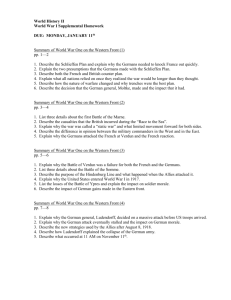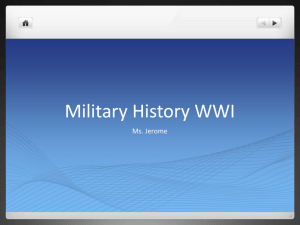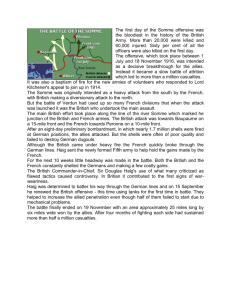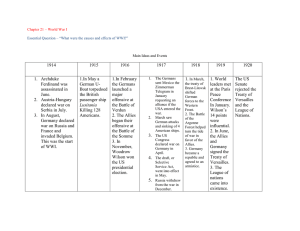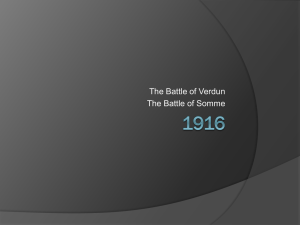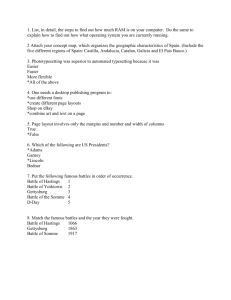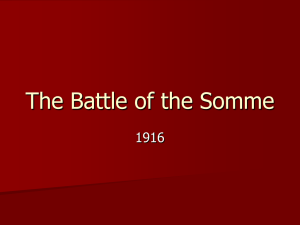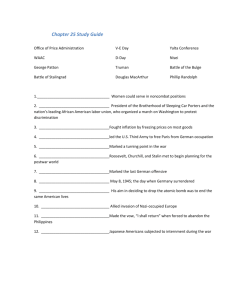SOCIAL STUDIES 20
advertisement
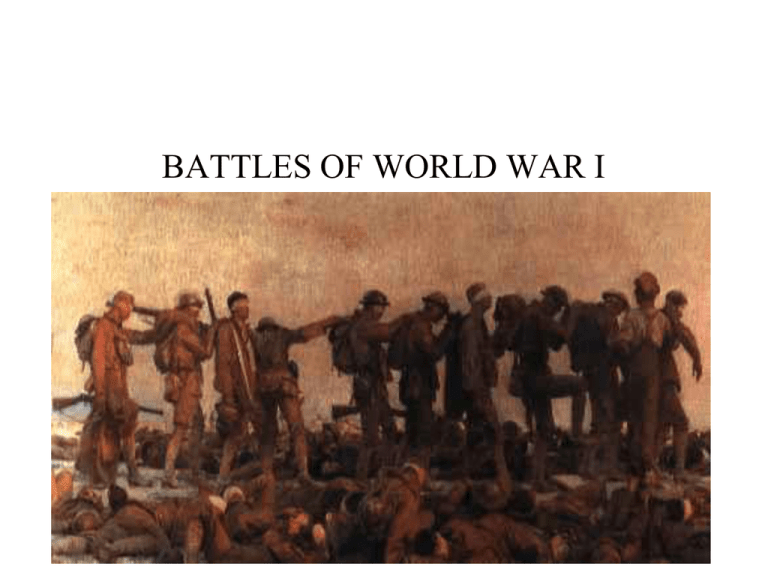
BATTLES OF WORLD WAR I Major World War I Battles Battle of Tannenburg: Aug. 1914, Russia’s worst defeat in World War I First Battle of the Marne: Sept. 1914, Allies halted German advance, saving Paris from occupation First Battle of Ypres: Oct.–Nov. 1914, last major German offensive until 1918 Battle of Gallipoli: Apr.–Dec. 1915, failed attempt of the Allies to knock Turkey out of the war Battle of Verdun: Feb.– Dec. 1916, longest battle of World War I with huge loss of life Battle of the Somme: July– Nov. 1916, first great offensive of the British, best remembered for its staggering loss of life Third Battle of Ypres (Passchendaele): July–Nov. 1917, so many losses that the name Passchendaele came to mean senseless slaughter Battle of Caporetto: Oct.–Nov. 1917, tremendous victory for the Central Powers Major Battles and Events • Marne - 1914-North of Paris the French stop the German advance and ruins the Schlieffen Plan. • After this point the war becomes a stalemate and they dig into the Trenches. • The front lines change little for the rest of the war. • Christmas Truce- 1914- Christmas Eve the soldiers on the front hold up candles and sing Christmas Carols. • On Christmas day they agreed not to fight and came out of their ditches to meet in the middle and hold funeral services and bury the dead. • Verdun- 1916- Place of Legendary battles, and importance, city surrounded by underground tunnels. • German offensive goal to kill (attrition) not for land, to get other side to surrender because of high body count. • Started with a heavy artillery attack, French and Germany forces clash after 9 months and 1 million dead or wounded nothing is accomplished. • Somme - 1916- North of Somme- 30 miles where the British try to break the German lines. • Fought at same time as Verdun in attempt to relieve pressure. • Artillery bombardment for 7 days believed to destroy Germans. • When the British advances across no mans land they are slaughtered 20,000 in one day. • 1 million dead or wounded in six months, 6 miles changed hands • Gallipoli- The British (Australians) assault on a Turkish peninsula in an attempt to open the strait to the Black Sea and their ally the Russians for re-supply. • British are unable to breach the high cliff and dig in at the beaches and get stuck in a stalemate. • Lost 250,000 men and withdrew in Jan. 1916. • Genocide- mass murder of a group usually ethnic based. Muslim Turks force Christian Armenians in the north by the Russian border to leave their homes and then murdered them or left them to starve in the desert. 500,000 die Other Fronts • Western Front- 475 miles of trenches from Swiss border through France and Belgium to the Atlantic Ocean. • Italian Front- Austria- Hungary fights Italy along the northern border, they break through Italian lines late 1917• Battle of Caporetto- but are pushed back with the help of the Allies • Balkan Front-Austria- Hungary overruns Serbia and fights the Allies along the border of Greece. • Fighting with the Turks at Gallipoli over the water ways to the black sea. • Rumania joins in with Allies, also overran. • Eastern Front- After Battle of Tannenberg Russia continues to be beaten, Germans make their way into Russia. • At first Russia does well against Austria but 1915 continues to be driven back into Russia by Austria also. • Russian army is poorly equipped, not enough food, clothing, weapons, moral is very low. Overview • 65 million combatants from 30 countries representing every continent. – 29 million become casualties. • Naval battles around the world and land battles in Europe, Africa, and Asia. • Triple Alliance = Germany, Austria, Italy – +Turkey + Bulgaria - Italy = Central Powers • Entente Cordiale = Britain, France – + Russia + Italy + (later) US = Allied Powers • Revolutionary technology, but evolutionary tactics(?) 3 How Did the War Become a Global Conflict? EASTERN EUROPE In August 1914, Russian armies pushed into eastern Germany. SOUTHERN EUROPE In 1915, Bulgaria joined the Central Powers and helped crush Serbia. After Russia was defeated in the battle of Tannenburg, armies in the east fought on Russian soil. OUTSIDE EUROPE Japan, allied with Britain, tried to impose a protectorate on China. The Ottoman empire joined the Central Powers in 1914. Arab nationalists revolted against Ottoman rule. THE COLONIES The Allies overran German colonies in Africa and Asia. The great powers turned to their own colonies for troops, laborers, and supplies. 1914 • June 28, 1914 Archduke Franz Ferdinand, heir to the throne of the Austro-Hungarian Empire, is assassinated in Sarajevo. • July 28 Austria-Hungary declares war on Russia. • August 1 Germany declares war on Russia. • August 3 Germany declares war on France. • August 4 Great Britain declares war on Germany. • August 4 Germany invades neutral Belgium. • August 26-30 German army, led by Erich Ludendorff and Paul von Hindenburg, achieves its greatest victory of the war on the Eastern front against Russia at the Battle of Tannenberg. • September 5-10 First Battle of the Marne halts German invasion in France. • September 15 First trenches of the Western front are dug. “Belgium is a country, not a road” • King Albert I of Belgium denied permission • August 2, 1914 Germany declared war on France – Why??? – The Schlieffen Plan! • August 4, 1914 Great Britain declared war on Germany for violating Belgian neutrality The Powers Prepare for War July 23 – August 3, 1914 June 28, 1914 Assassination of Archduke Franz Ferdinand July 5-6, 1914 Germany supports Austria-Hungary July 28, 1914 Austria-Hungary declares war on Serbia July 31, 1914 German forces begin to mobilize August 1, 1914 Germany declares war on Russia & France With Russia mobilizing, Germany has no choice but to demand an immediate halt or to declare war before anyone else can. Russia refuses to stop it mobilization and within hours on August 1, 1914 Germany is at war with Russia. Kaiser Wilhelm II needs no excuse to declare war on France and does so two days later on August 3. This sets up the first stage of the "Schlieffen Plan". The Schlieffen Plan • Invade western front 1st • After defeating France concentrate on the Eastern front • Avoid fighting a 2 front war Schlieffen Plan • Germans want to finish off French before Russia is ready to fight. • Germans believe French will immediately try to retake Alsace-Lorraine. • Original plan called for economy of force on the left while heavily weighting the right flank – Von Moltke revised and distributed forces more evenly across the front. • Plan failed when Germans were held up by Belgians, then stopped by French and British at the Battle of the Marne. – Russians also mobilized more quickly than expected. German Aggression Leads the Way The Outbreak of War (1914) • Germany had prepared a battleplan well in advance of the outbreak of war & used the Russian mobilization as an excuse to launch their attack • THE SCHLIEFFEN PLAN (Germany’s 2-Part Plan for the War) A) Attack France thru NEUTRAL Belgium to avoid forts along the French-German border (defeat France in a matter of weeks) B) Reverse course and attack Russia before it was fully mobilized for war • The “Offensive” strategy & attack thru Belgium will be critical in Germany being blamed for “starting” WWI The Schlieffen Plan The Schlieffen Plan’s Destructive Nature The Schlieffen Plan’s Destructive Nature • Germany made vast encircling movement through Belgium to enter Paris • Underestimated speed of the British mobilization – Quickly sent troops to France The Schlieffen Plan’s Destructive Nature • Sept 6-10, 1914 – Battle of Marne – Stopped the Germans but French troops were exhausted – Both sides dug trenches for shelter STALEMATE Paris: The First Day of Mobilization, Sunday August 2 1914 The German Attack August 4, 1914 August 4, 1914 German forces invade neutral Belgium August 26-30, 1914 Battle of Tannenberg October-November, 1914 First Battle of Ypres December 25, 1914 Unofficial Christmas Truce on the Western Front The French thought that Germany's advance into Belgium was a diversion. Most of the French army moved northeast to attack Germany through the lost provinces of Alsace and Lorraine. The first major battle on the Eastern front occurred when German forces surrounded and destroyed the Russian army at the Battle of Tannenberg. This August 1914 battle was Germany's greatest victory of the war. First Battle of the Marne September 5 -10, 1914 German plans for the Western Front began to fall apart in September of 1914. As the German right flank drove deeper, it was separated from the rest of the invading German force. This made it vulnerable and forced the Germans pulled up twenty-five miles short of Paris. This was France’s chance to attack. What followed was the First Battle of the Marne where the German advance was stopped The First Battle of the Marne • The German army quickly advanced through northern France and after only one month of fighting were barely 25 miles from Paris. • The French, however, would not give up. The Battle • The French launched a counterattack along the Marne River east of Paris on September 7, 1914. • This battle became known as the First Battle of the Marne. • 2 million men fought on a battlefront that stretched 125 miles. • After five days and 250,000 deaths, the French had rallied and pushed the Germans back some 40 miles. The Aftermath • The French paid a heavy price, as countless redcoated French troops had fallen in the battle. • Despite the loss of life, it helped the Allies by giving Russia more time to mobilize for war. • Once Russia mobilized, Germany had to pull some of its troops out of France and send them to fight Russia on the Eastern Front, which stretched from the Black Sea to the Baltic Sea. BATTLE OF THE MARNE • The 1st Battle of Marne - The First World War - Sept 1914 • Germans continued their push towards Paris. This was part of the Schlieffen Plan • British and French troops retreated to positions south of the Seine and Marne rivers. French 6th Army launched a counter attack. • French managed to save Paris. (Reinforcements were sent in taxi's from Paris.) BATTLE OF THE MARNE • • • • Around 600 taxis used to transport 6,000 French troops to battle. Over 2 million troops fought in First Battle of the Marne. 260,000 ALLIED CASUALTIES 250,000 GERMAN CASUALTIES Battle of the Marne Sept.-Nov. 1914 •Germans encounter heavy resistance at the Marne River •French & Germans dig defensive trenches •Halts German offensive A Massive “Meat Grinder”: The Western Front • Early Battles of the War --The Battle of the Marne (September 6, 1914) • Immovable front for two and a half years • Trench warfare --25,000 miles of trenches • Cavalry gives way to infantry WWI on the Eastern Front • Eastern Front of the great war had a profound impact on the remainder of the 20th century •Grim statistics for the Eastern war: •more than three-million men dead, •more than nine-million men wounded, •and every major country which participated lost its form of government. •Russia collapsed completely and catastrophically State of the Russian Army •Russian Army of World War One has become notorious for its reputation as a large, ill-equipped force •Russia's Imperial Troops were actually well trained and equipped •Real problem: inadequate transportation infrastructure, which was not able to supply and maintain Russian field formations at wartime establishments, and poor command decisions •Equipment: the average Russian soldier in the 1st and 2nd Line had sidearms, rifles and machine guns equal to his German counterparts, and probably superior to the Austrians •standard Russian Field Guns, the 76.2 mm and 122 mm, were robust enough to be used in World War Two and still be in reserve units in the 1980's Pre-War Decisions •Russian Army High Command had maintained a lively pre-war debate over what action would be taken in case of war with Germany • by 1910 it was decided to launch major offensive operations immediately upon the outbreak of any war •decision catered to the "spirit of the offensive" which then pervaded European military thought, and as a result most Russian fortress units were deactivated •age-old Russian strategy of defense-in-depth supported by counteroffensives was cast aside •would exact a brutal toll in Russian lives, which in turn helped to spur later unrest Austria-Hungary •Austro-Hungarian Army of 1914 had been starved of proper equipment and resources throughout the pre-war period •composed of an increasingly nationalistic soldiery, three-quarters of whom were from Slavic recruiting districts •these troops proved to be reluctant to follow Austrian officers into combat against their Russian brethren •became a major liability, especially after the enormous losses suffered during the first year of war. Germany on the East •main German armies in the East operated with characteristic efficiency •troops enjoyed the luxury of fighting the battles of maneuver for which they had been trained • Russian front saw the rise of the great German "artillery virtuosos" of the war like Lieutenant Colonel Georg Bruchmüller • Bruchmüller orchestrated artillery firepower with ferocious efficiency • undertook aggressive training measures to assure near perfect coordination between the artillery and infantry branches of the army Opening the War on the Eastern Front •Eastern half of the Great War began on August 17, 1914 w/ the Battles of Stalluponen and Gumbinnen •Russian General Pavel Rennenkampf's First Army invaded Eastern Prussia in a full scale offensive •Two days later, General Alexander Samsonov's Second Army attacked around the right flank of the German Eighth Army commanded by General Friedrich von Prittwitz •This was achieved despite the fact that Second Army was fighting at twothirds strength due to the slow Russian mobilization. •Prittwitz, certain that he could not hold against the two armies facing him, informed high command that he intended to withdraw to the Vistula River, abandoning most of East Prussia including Königsberg Battle of Tannenberg •Prittwitz was relieved of duty and replaced by Field Marshal Paul von Hindenburg and his new Chief-of-Staff, Erich Ludendorf. •Along with the staff at East Prussian Army Headquarters, they planned a counteroffensive against the Russians. •By August 27 they had already laid the plans and fallen on Samsonov's weak Army, taking it in both flanks in a near perfect double envelopment •The Battle of Tannenberg ended by August 30 when Samsonov's entire command disintegrated at a cost of 92,000 captured and tens of thousands of other casualties. Battle of Tannenberg May-August 1914 •Germans & Austrians push Russians out of East Prussia & Carpathian Mts. •Russians retreat beyond Brest-Litovsk, Poland. •Russia--one million killed or wounded; one million captured. The Winter War of 1914-1915 • • • • • Winter 1914-15: von Hoetzendorf appealed to the Germans to support an offensive he hoped would force the Russians off the Carpathian Mountains German senior command agreed on a thrust deep into Russian lines out of East Prussia resulting "winter war" inflicted 90,000 casualties on the Russians, but petered out when the Austrian forces to the south utterly failed to dislodged the Russians. Austria suffered another embarrassing defeat, and even lost control of Dukla Pass, a prime route onto the Hungarian plains severe weather and their unfortunate supply situation prevented the Russians from moving into Austria-Hungary German Control • • • • • • • • • • May 1915: Germans took over command of the Eastern Front used their units to support the fragmented Austrian formations next offensive came on May 1, with a sharp attack on the Russian lines at Gorlice offensive penetrated more than two-hundred miles in two weeks triggered the collapse of the entire Russian Southern Front German and Austrian formations pushed northward capturing Warsaw in August September: Gen. Max von Gallwitz' Twelfth Army attacked into the Courland toward Riga Russian front line fell apart strongholds of Novo-Georgiesk and Brest-Litovsk fell to the Germans Took until the end of September for the Russian line to re-form The Eastern Front • Russian army moved into Eastern Germany on August 30, 1914 – Defeated • The Austrians kicked out of Serbia • Italians attacked Austria in 1915 • G. came to Austrian aid and pushed Russians back 300 miles into own territory Nicholas Takes Command • Russian Tsar Nicholas intervened and assumed personal command of the army • decision would have grave consequences. • territory captured by the Central Powers to date included all of Poland, Lithuania and Latvia. • two million Russian troops were lost during the course of the year, half of them prisoners • Central Powers of Germany and Austria-Hungary lost a total of nearly one-million A Romanian Whoopsy • Romania entered the war on the side of the allies • invaded Transylvania instead of preparing an adequate defense. • mistake gave the Germans the opening they needed • ensuing counter-offensive achieved the total collapse of Romania to the Central Powers • Germany and Austria gained control of vast coal and wheat fields, but added over 200 miles of front to their lines Troubles All Round… • Russian industry proved unable to continue manufacturing new equipment in sufficient quantities to replace staggering losses, especially in small arms and ammunition. • Late 1916: several nations across Europe began to suffer from mutinies and revolts as troops became disillusioned • Russia slowly edged toward open revolt • dual monarchy of AustriaHungary edged toward complete dissolution. Russian Disintegration • • • • • • • 1917--the Russian Army's officer corps increasingly demoralized by the poor progress of the fighting Grossly outnumbered Germans had proven to be dangerous and cunning opponents Russian royal family's intervention didn’t improve anything repeated catastrophes suffered by Russian field armies squelched what patriotism had existed three years earlier entire governing system slowly fell apart by March, some Army units began ignoring their orders situation made worse as growing Communist rebel groups exaggerated reports of minor events: I.e. revolt of a Russian Guard depot formation at Petrograd (carried out by trainees and depot troops, not by fully trained Imperial Guardsmen) The Western Front • “The Race with Death” -- “Going over the top” -- “No Man’s Land” • Gap between officers and enlisted men • Daily routine of the World War I soldier YPRES • First Battle of Ypres was last major battle of the first year (1914) • This battle marked the end of the Race to the Sea where Germans tried to reach French ports of Calais and Dunkirk, which were the main supply routes for the British Expeditionary Force. • Germans called the battle "The Massacre of the Innocents" (German "Kindermord"). • Many of German units consisted of enthusiastic students. Their offensive had been stopped by a British force, which although outnumbered was highly professional having learned many lessons from the Boer War. • The BEF was effectively destroyed at First Ypres but bought the British valuable time to reinforce the lines Battle of Ypres, Belgium November 1914 •Last open Battle of the Western Front •British and French halt German advance to English Channel •German & French Casualties: •300,000 killed; 600,000 wounded 1915 • January 19, 1915 First German Zeppelin air raid on England. • February 4 Germany declares a submarine blockade of Great Britain. Any boat approaching England is considered a legitimate target. • April 22-May 5 Second Battle of Ypres marks first use of chemical weapons. • April 25 Allies begin assault on Gallipoli peninsula in Turkey. • May 7 Sinking of the passenger ship Lusitania. • May 23 Italy declares war on Austria-Hungary. • August 30 Germany responds to U.S. anger by ceasing to sink ships without warning. • December 28 Allies begin withdrawal of troops from Gallipoli. Second Battle of Ypres April 22-May 31, 1915 The Second Battle of Ypres involved four battles around Ypres. The first of these four battles began on 22 April 1915 as a surprise offensive by the German 4th Army on the Allied front line. This attack saw the first use of a new German weapon on the Western Front: poisonous gas. A breeze moving towards French troops carried the deadly gas. It had a devastating effect on the French and the German infantry made a significant advance into Allied territory. During the next four weeks the Allied Forces of Belgium, France and Britain fought to hold off the successful German advance and to regain the ground that had been lost north of Ypres. The fourth battle ended on 25 May 1915. Battles on the Western Front While people on the home front supported their troops, the war in Western Europe was going badly for the Allied Powers. The Italian Front The Battle of Verdun • Germans planned assault on • Italy joined Allied Powers, French fortress, Verdun May 1915 • Sent forces against AustriaHungary at border with Italy • Series of back-and-forth battles • Little progress made • Believed French would defend fortress at all costs • Battle of Verdun meant to kill, injure as many French soldiers as possible • 400,000 French casualties in 10 months of fighting, almost as many for Germany The Battle of the Somme • British launched attack in Somme River area to pull German troops away from Verdun • Main assault during 1916, but no major breakthrough • Both sides lost great number of troops; British suffered nearly 60,000 casualties on the first day of fighting The Third Battle of Ypres • Failed French offensive caused rebellion among French soldiers, spring 1917 • British began offensive near Ypres, Belgium, site of German attacks • Third Battle of Ypres a disaster for British • After 3 years of battle, front lines remained virtually unchanged Battle of Verdun • 10 months • 700,000 men killed Case Studies in Industrial Warfare • Battles of Attrition • The Battle of Verdun (February-June, 1916) --German attack opened by most massive military bombardment in history --longest single battle of the war --The “sacred road” --600,000 men died The Battle of Verdun February 21. 1916 – July 1916 The Allies had planned to launch a joint French and British assault in the region of the Somme. The target date was the middle of 1916. However, in February the Allied plan was upset when the Germans began an assault on the fortress-ringed city of Verdun. The belief was that Verdun was essential to the French that France would fight to the death. On February 21, the German artillery barrage began and, for the next several months both sides unleashed soldiers and shells at each By Christmas, when the battle finally ended, 800,000 men had lost their lives. One hundred and twenty-five miles northwest of Verdun, the British and French armies joined at the Somme river. A French-British offensive was planned here for 1916 to relieve pressure on the French at Verdun. Battle of Verdun February-July 1916 •Germans believed they could win a war of attrition w/ Allies. •Verdun, a series of fortifications in rolling hills. •Almost 1,000,000 killed or wounded. •French lost 325,000 (90,000 killed), in one assault at “Dead Man’s Hill.” Battle of Verdun 1916 •24 million shells used •equates to 1,000 shells per square meter of the Battlefield. VERDUN • "They shall not pass." -Philippe Pétain • fought between Feb and Dec 1916. • resulted in nearly one million deaths and an additional 450,000 wounded and missing. • one of longest and bloodiest battles in history. VERDUN • Douaumont Ossuary (remains of 130,000 unknown soldiers) and National cemetery (15,000 graves of identified French soldiers). • Germany captured a centre of France's fortifications -Fort Douaumont but could not capture Verdun itself. Verdun • Germans assaulted French forces with massive artillery barrage and then advanced on French trenches using flamethrowers for the first time. VERDUN AFTERMATH • apparent successes of fixed fortification system (with the exception of Fort Douaumont) led to adoption of the Maginot Line as preferred method of defense along the Franco-German border during the interwar years. • France's army was plagued not with desertions, but rather with a general refusal to march face-first into the teeth of Germany's impregnable positions. • France's troops remained in their trenches, willing to fight only in a defensive capacity. The Battle of Verdun was fought from Feb. 21, 1916 through Dec. 15, 1916. It was between the French and Germans. The French won. The French suffered 371,000 casualties; the Germans suffered 337,000 casualities. Many men were also maimed. The battle became a symbol of French determination to hold ground and repel the enemy at any cost. Case Studies of Industrial Warfare (cont) • The Battle of the Somme (JulyNovember, 1916) --Seven Days and Seven Nights of British bombardment --60,000 British dead in 12 minutes --1 million dead for just 7 miles of land • The Changing atmosphere of War --complete breakdown of human existence The Battle of the Somme July 1,1916 –November 1916 The Allies had planned to launch a joint French and British assault in the region of the Somme. The target date was the middle of 1916. However, in February the Allied plan was upset when the Germans began an assault on the fortress-ringed city of Verdun. The belief was that Verdun was essential to the French that France would fight to the death. On February 21, the German artillery barrage began and, for the next several months both sides unleashed soldiers and shells at each By Christmas, when the battle finally ended, 800,000 men had lost their lives. During this horrendous fighting, the French sent frantic appeals to Sir Douglas Haig, the new British commander, to hasten the Somme offensive and to take the pressure off Verdun. Battle of the Somme July-Nov. 1916 •British & French felt a massive assault on German forces would turn tide of war. •After a week of constant bombardment, the British came out of their trenches. •By the end of the first day, British casualties were 110, 000 (19,000 dead). BATTLE OF THE SOMME • 1916- Battle of the Somme was one of the largest battles, with more than one million casualties. The British and French forces attempted to break through the German lines along a 25 mile (40 km) front north and south of the River Somme in northern France. One purpose of the battle was to draw German forces away from the battle of Verdun; however, by its end the losses on the Somme had exceeded those at Verdun BATTLE OF THE SOMME • The battle is best remembered for its first day, 1 July 1916, on which the British suffered 57,470 casualties of which 19,240 were killed or died of wounds. It remains the bloodiest day in the history of the British Army. BATTLE OF THE SOMME MOVIE • For the first time the home front in Britain was exposed to the horrors of modern war with the release of the propaganda film, The Battle of the Somme which used actual footage from the first days of the battle. • The film spanned five reels and lasted 63 minutes . It was first screened on 10 August, 1916, while the battle was still raging. • On 21 August the film began showing simultaneously in 34 London cinemas. SOMME MOVIE CONT… • film was screened for British soldiers at rest in France where it provided new recruits with some idea of what they were about to face. Soldier's main complaint was failure of film to capture sounds of battle. However, as a silent film, the titles could be remarkably forthright, describing images of injury and death. • film was shown to British public as a morale booster and was favourably received. British public's response to film was enormous with an estimated 20 million tickets being sold in two months. On this basis, The Battle of the Somme remains one of the most successful British films ever. Battle of the Somme 1916 •Britain lost 420,000; France-200,000; Germany-650,000. •More British soldiers died in the first three days at the Somme than Americans in WWI, Korea & Vietnam combined. •Ends in a Stalemate The Battle of Passchendaele 31 July 1917 – 10 November 1917 •This battle was fought for control of the city of Passchendaele. • The city was located on a ridge that sat above the rest of the land, offering whoever had control of the city a strategic advantage in the war. •The plan was to drive through the German forces and reach the Belgium coast where they would capture the submarine bases located there. •Also, by distracting the Germans there would be less pressure on the French, who were suffering from low morale. Where oh where~ • Ypres, West Flanders, Belgium • Mud soaked, hell ridden, shell molested badlands! When The battle of Passendale was apart of a campaign which is also known as the Third Battle of Ypres. • The campaign lasted from July 31st to November 10th, 1917 • There had been previous battles revolving around the district of Ypres in both 1915 and 1916. Significance • The city of Passchendaele has strategic significance. • You must pass through here in order to reach the coast. • The ports located there are a key part shipping equipment and goods. • This battle was important to the Belgium people because it was the last city left free of German rule. • Upon arriving at Passchendaele with Canadian Troops, Canada’s Commander-in-Chief General Sir Arthur Currie estimated that 16,000 would die in order to complete this task. • Passchendaele is the current spelling for the city of Passchendaele, and it’s old spelling is used specifically as a reference to the battle. PASSCHENDAELE • • Battle of Passchendaele, otherwise known as Third Battle of Ypres, fought by British, ANZAC, & Canadian soldiers against German army near Ypres village is now known as Passendale, the term Passchendaele alone is now used to refer to this battle. The label "Passchendaele" should properly apply only to battle's later actions in Oct–Nov 1917, but has come to be applied also to the entire campaign from July 31. After three months of fierce fighting, the Canadians took Passchendaele on Nov 6, 1917, ending the battle. PASSCHENDAELE • "...I died in Hell • (they called it Passchendaele) my wound was slight • and I was hobbling back; and then a shell • burst slick upon the duckboards; so I fell • into the bottomless mud, and lost the light" • -- Siegfried Sassoon Weaponry • Mark IV Tanks were used by the British, mainly in the battle of Messiness Hill – just prior and South of the battle of Passchendaele (Third battle of Ypres) Weaponry Cont’. Strategies • “Bite and Hold” : where the attackers were to gain a small portion of front, and hold it against counter-attacks. • 1,295 guns were concentrated in the area • Germans had artillery accurately aimed in No-Man’s Land. Conditions • Ground conditions during the whole YpresPasschendaele action were atrocious. • Continuous shelling destroyed drainage canals in the area, and unseasonable heavy rain turned the whole area into a sea of mud and water-filled shell-craters. • The troops walked up to the front over paths made of duckboards laid across the mud, often carrying up to one hundred pounds (45 kg) of equipment. • It was possible for them to slip off the path into the craters and drown before they could be rescued. • The trees were reduced to blunted trunks, the branches and leaves torn away, and the bodies of men buried after previous actions were often uncovered by the rain or later shelling. • First battle of Passchendaele produced 13,000 Allied casualties; which stacked on top of the 100,000 dead already. • Germans lost about 270,000 men. • British Empire forces lost about 450,000, including 36,500 Australians and 16,000 Canadians - the latter of which were lost in the intense final assault between October 26 and November 10; • 90,000 British and Australian bodies were never identified, and 42,000 never recovered. Casualties German British Australia n Candian Quotations – "I died in Hell – (they called it Passchendaele); my wound was slight – and I was hobbling back; and then a shell – burst slick upon the duckboards; so I fell – into the bottomless mud, and lost the light" • — Siegfried Sassoon The man beside him, who had been through the campaign, replied tonelessly, 'It's worse further on up.'" • — Leon Wolff, In Flanders Fields "Passchendaele was just a terrible, terrible place. We used to walk along these wooden duckboards - something like ladders laid on the ground. The Germans would concentrate on these things. If a man was hit and wounded and fell off he could easily drown in the mud and never be seen again. You just did not want go off the duckboards." — Private Richard W. Mercer (911016) Iron Maiden: Passchendaele In a foreign field he lay lonely soldier unknown grave on his dying words he prays tell the WORLD of Paschendale Relive all that he's been through last communion of his soul rust your bullets with his tears let me tell you 'bout his years Laying low in a blood filled trench killing time 'til my very own death on my face I can feel the falling rain never see my friends again in the smoke, in the mud and lead smell of fear and feeling of dread soon be time to go over the wall rapid fire and the end of us all • Whistles, shouts and more gun fire lifeless bodies hang on barbed wire battlefield nothing but a bloody tomb be reunited with my dead friends soon many soldiers eighteen years drown in mud, no more tears surely a war no one can win killing time about to begin Home, far away. From the war, a chance to live again Home, far away. But the war, no chance to live again • The bodies of ours and our foes the sea of death it overflows in no man's land God only knows into jaws of death we go... Crucified as if on a cross allied troops, they mourn their loss German war propaganda machine such before has never been seen swear I heard the angels cry pray to God no more may die so that people know the truth tell the tale of Paschendale Cruelty has a human heart everyman does play his part terror of the men we kill the human heart is hungry still • I stand my ground for the very last time gun is ready as I stand in line nervous wait for the whistle to blow rush of blood and over we go... Blood is falling like the rain its crimson cloak unveils again the sound of guns can't hide their shame and so we die in Paschendale • Dodging shrapnel and barbed wire running straight at cannon fire running blind as I hold my breath say a prayer symphony of death as we charge the enemy lines a burst of fire and we go down I choke a cry but no one hears feel the blood go down my throat Home, far away. From the war, a chance to live again Home, far away. But the war, no chance to live again Home, far away. From the war, a chance to live again Home, far away. But the war, no chance to live again See my spirit on the wind across the lines beyond the hill friend and foe will meet again those who died at Paschendale VIMY RIDGE • • • • • • • seminal event in Canadian history Vimy, located in northern France, was one of most heavily defended points on Western Front and was thought to be impregnable. Germans fortified it with tunnels, 3 rows of trenches behind barbed wire, and numerous machine gun nests. French and British had suffered thousands of casualties in previous attempts to take Ridge; the French alone lost 150 000 men at Vimy in 1915. The ridge was a crucial point that allowed Germans to control much of surrounding territory. Canadians determined to learn from mistakes of French and British and spent months planning their attack. Built a replica of the Ridge behind own lines, and trained using platoon-level tactics, including issuing detailed maps to ordinary soldiers rather than officers or NCOs alone. Each platoon given a specific task by commanding officers, rather than vague instructions from an absent general. employed older techniques such as detonation of large mines under German trenches. VIMY RIDGE • • • On April 2, 1917, the Canadians launched largest artillery barrage in history up to that point. They shelled the German trenches for the next week, using over one million shells. The attack was loud enough that it could be heard in London. Easter Monday, April 9, the 30 000-strong Canadians began the attack, using a creeping barrage, a new technique whereby soldiers walked across No-Man's Land just behind a continuous line of shells After less than two hours, three of the four Canadian divisions had taken their objectives; the fourth division, however, was caught by the machine gun nests on the highest point of the Ridge known as Hill 145. The 87th Battalion suffered 50% casualties. VIMY RIDGE CONT… • • • • By April 12 the Canadians controlled the entire Ridge, at a cost of 3598 men killed and 7104 wounded. The Germans suffered approximately 20 000 casualties. The Canadians also took 4,000 German POWs. It was the first time in Canadian history that its army fought as a complete organization in an independent battle. The capture of the Ridge by the Canadian Corps, under the command of British General Julian H.G. Byng with Canadian General Sir Arthur Currie acting as Chief-of-Staff), was a turning point for Allies. The success of the Canadian forces in this battle and others earned them a place at the post-war peace negotiations, a clear mark of the nation's independence from Britain. Wider Involvement • Ottomans entered war in 1915 on side of the Central Powers – Wanted to acquire Russian territory – Turkey slaughtered millions of Armenians to get their land – Britain wanted to protect trade routes to India • Arabs promised their own country if they would join with Britain against the Ottomans War around the World Much of the early fighting took place in Europe, but the conflict quickly became a true world war as fighting spread around the globe. Over 30 nations officially took sides in the war. Gallipoli Campaign Spring 1915 Major Loss • Ottoman Empire joined Central Powers, late 1914 • Allies landed force on Gallipoli Peninsula • Ottoman subjects in Arabian Peninsula rebelled later in war • Controlled sea passage, Dardanelles • Attempted to destroy guns, forts on Dardanelles • British sent T.E. Lawrence to support Arabs • Gave up after months of fighting, 200,000 deaths • Arabs overthrew Ottoman rule • Used by Allies to ship supplies to Russia The Global Nature of WWI • In 1915 Britain landed British, Australian & New Zealand troops at Gallipoli in the Dardanelles Straits in an attempt to: a) knock Turkey out of the war b) open up access to the Black Sea & Russia • The campaign would be a disaster as Gallipoli is one of the most easily defended territories in the world – high cliffs, small beachheads – over 50% of the Allies troops were killed or wounded (approx. 250,000) • Both France & Britain mobilized troops from their African colonies – usually in support roles (construction, guard duty) – more than 2 ½ million participated in some way • Britain mobilized forces from India to fight against the Ottomans in the Middle East – T.E. Lawrence (Lawrence of Arabia) persuaded Arab princes to rise up against the Ottomans – by 1917 much of their former empire had revolted • Japan & Australia attacked & seized German colonies in Pacific • The Ottoman Empire waged a campaign of genocide against the Armenians in the Caucasus – killing over 1 million & displacing millions more – Adolf Hitler studied this event intensely & noted the lack of response from the world to stop the slaughter Battle of Gallipoli April-Dec. 1915 •Objectives: •Open the Dardanelles to supply Russia through the Black Sea. •Prevent Turks from disrupting Suez Canal trade. •Strengthen British colonial interests in the Middle East. Gallipoli Campaign The Gallipoli Campaign was an attempt to gain control of the Dardanelles and capture Constantinople. This would open a Black Sea supply route to Russia. The idea originated with Winston Churchill, then First Lord of the Admiralty. After the failure (March 1915) of a British naval force to open the straits, British, Australian, and New Zealand troops landed (Apr. 25) at various points on the east coast of the Gallipoli Peninsula, while a French force landed on the Asian side of the straits. The Turks were ready and prevented the Allies from making any important gains. Churchill’s plan failed due to Allied bureaucratic incompetence. Allied cooperation was poor and there was lack of coordination between land and naval forces. The result was a premature naval attack without sufficient support from the army. The two-month delay between the navy's arrival at Gallipoli (Feb., 1915) and the arrival of land forces (Apr., 1915) gave the Turkish army plenty of time to reinforce its troops. The landing (Aug., 1915) at Suvla on the west coast of the peninsula was followed by months of costly fighting. Eventually, the Allies withdrew from the area on Jan. 9, 1916. The evacuation, unlike the attack, has been described by some as brilliantly executed. Gallipoli 1915 Allied troops, mostly ANZUS (Australian & NZ, lost between 200-400,000 before retreating. GALLIPOLI • The Battle of Gallipoli took place on the Turkish peninsula of Gallipoli in 1915. A combined Allied operation was mounted in order to eventually capture the Ottoman capital of Constantinople. The attempt failed, and an estimated 131,000 soldiers were killed and 262,000 wounded. • In Britain it is called the Dardanelles Campaign and in Australia and New Zealand it is known simply as Gallipoli GALLIPOLI MOVIE • The film Gallipoli (1981) is an account of several young men from rural Western Australia who enlist in the Australian armed forces. They are sent to Turkey, where they take part in the Battle of Gallipoli. • It stars Mel Gibson. • The climax of the movie occurs on the Anzac battlefield at Gallipoli and depicts the ill-fated attack at the Nek on the morning of the August 7, 1915 GALLIPOLI War around the World Other Fighting • War also fought in Asia and Africa • Japan declared war on Germany – Part of military agreement with Great Britain – Japanese captured German colonies in China – British, French attacked German colonies in Africa • Allied colonies scattered around world made contributions to war – Some colonists worked as laborers to keep armies supplied – Others fought, died in battles in hope of winning independence – Hopes were in vain 1917 • February 1, 1917 Germany again declares unrestricted submarine warfare. • April 6 The United States declares war on Germany. • July 6 T.E. Lawrence and the Arabs capture Aquaba. • July 16-November 10 Third Battles of Ypres, known as Passchendaele, results in minor gains, but still no breakthrough. • November 7 Bolshevik socialists, led by Lenin, overthrow Kerensky's government. • December 3 The new Russian government, represented by Leon Trotsky, signs an armistice with Germany. • December 9 British capture Jerusalem. 1918: The End Nears Left: Over four months in 1918 the German army launched five major assaults at different parts of he allied line. Initially the plan worked. But for every allied trench captured, there was always another for the Germans to take. Soon the elite German storm troopers were a depleted force. As desperation set in, the Germans resorted to the tactic of mass assault. Large numbers of casualties resulted. The Hindenburg Line- the last and strongest of the German army's defence - consisted of three well-defended trench systems established in 1917. Throughout September 1918, Australian forces had helped the British army to secure positions from which an attack on the Hindenburg Line could be launched. On 18 September 1918, an attack was launched on the first part of the Hindenburg Line.Troops, supported by huge artillery barrages, attacked the heavily fortified German defences and machine-gun posts. Using only eight tanks (as well as dummy tanks) to distract the Germans 4,300 prisoners were taken. On 29 September, the line was finally broken.. The fighting lasted four days and resulted in heavy losses. Eventually, the Allies broke through the third and final stage of the Hindenburg Line, and the Germans were forced to fall back. 1918 • January 8, 1918 President Woodrow Wilson declares his 14 points as the path to world peace. • March 21 Germans launch the first of five major offensives to win the war before American troops appear in the trenches. • April 25 British and Australian troops stop the German advance near Amiens • May 23 German shells land on Paris. • August 8 Allied counteroffensives on the Somme push the German army back. • September 29 Allied troops break through the German fortifications at the Hindenberg line. • November 11 At eleven o'clock on the eleventh day of the eleventh month of 1918, the war ends as Germany and Allies sign an Armistice. Battle of Belleau Wood – June, 1918 · This was the first battle involving U.S. troops. · The Germans were defeated after three weeks of battle. "American Marines in Belleau Wood” (1918) Georges Scott (1873-1943) * The Allied defense of Paris was the turning point of the war. Battle for Belleau Wood • 4 June 1918 Germans reach their “high water mark”, but are turned back by 5th Marines at Les Mares Farms, 50 miles from Paris. • 5 June 1918, 4th Marine Brigade (5th and 6th Regiments, 6th Machine Gun Battalion) enters Belleau Wood to stop German advance. French are retreating as Marines arrive. One Frenchman advises Marines to join the retreat, Capt Lloyd Williams replies “Retreat, hell. We just got here.” • Marines begin picking off Germans at 800 yards (200 yds considered far to Germans) Belleau Wood • June 6 1/5 charges twice. Sustains 410 and 1087 casualties, respectively. Marines gain toe hold on woods. – Dan Daly: “Come on you sons of bitches. Do you want to live forever?” • Marines fight until 16 June when an Army unit relieves them • 22 June Marines reenter fight. • 26 June Maj Shearer sends signal, “Woods are now entirely US Marine Corps.” • Victory was not the product of sound tactics, but of the discipline and determination of the Brigade. Teufel Hunden • Devil Dog title given Marines by Germans “Teufel Hunden” • “The 2nd American Division must be considered a very good one, and may perhaps even be reckoned as storm troops. The different attacks on Belleau Wood were carried out with bravery and dash. The moral effect of our gunfire cannot seriously impede the advance of the American riflemen.” German intel dispatch In view of the brilliant conduct of the 4th Marine Brigade… which in a spirited fight captured… Belleau Wood, fiercely defended by the enemy in force, the Commanding General, VI Army, decrees that henceforth in all official papers, Belleau Wood shall bear the name, Bois De La Brigade De Marine.” French citation dated 30 June 1918 I believe they are soldiers from Montezuma. At least when they advanced this morning they were all singing “From the Halls of Montezuma, to the Shores of Tripoli.” French soldier describing the unit fighting on his regiment’s right during WWI. Battle of the Argonne Forest – Sept.-Oct., 1918 · The battle was fought in an attempt to push Germany further out of France. · After forty-seven days and heavy casualties, the Germans retreated. American gunners battle through the Argonne Forest. The War Ends The Germans’ Last Offensive • At midnight on July 14, 1918, the Germans launched their last offensive at the Second Battle of the Marne. • U.S. blew up every bridge the Germans built across the Marne River, and the German army retreated on August 3, after suffering 150,000 casualties. • The Allies began a counterattack in September 1918 and, fighting as a separate army for the first time, defeated German troops at Mihiel, near the French-German border. Allies Push Forward • Allies continued their advance toward the French city of Sedan on the Belgian border, which held the main German supply railway. • By November, the Allies had reached and occupied the hills around Sedan. The Armistice • By 1918 the war crippled the German economy, causing food strikes and riots, and revolution swept across Austria-Hungary. • The Central Powers lacked the will to continue and started to surrender. • Austria-Hungary, and then Germany, surrendered, and the Allies demanded that Germany surrender its weapons and allow Allied occupation of some areas. •Armistice signed on November 11, 1918 @ 11 am •10 million soldiers killed, 20 million wounded WWI by the Numbers • Over 8 million Military Deaths • Over 21 million wounded • Over 2 million missing • Cost of $337 billion (1918 Dollars) • Over 2 million civilian deaths • An additional 20+ million will die from the 1918 global flu (Spanish Flu) epidemic – not directly related to the war * Approximately 13 million people died and 20 million were wounded in the war. Entente Powers Military Deaths Total Deaths Military Wounded Australia[1] Belgium[2] Canada[3] 61,928 42,987 64,944 61,928 104,987 66,944 152,171 44,686 149,732 France[4] India[6] Italy[7] Romania[13] 1,397,800 74,187 651,010 250,000 1,697,800 74,187 1,240,010 680,000 4,266,000 69,214 953,886 120,000 Russia[14] Serbia[15] United Kingdom[17] 1,811,000 275,000 885,138 3,311,000 725,000 994,138 4,950,000 133,148 1,663,435 117,465 205,690 10,353,813 12,809,280 United States[18] 116,708 Total (Entente 5,696,056 Powers) Central Powers Austria-Hungary[19] Bulgaria[20] Germany[21] Ottoman Empire[22] Total (Central Powers) Military Military Deaths Total Deaths Wounded 1,100,000 1,567,000 3,620,000 87,500 187,500 152,390 2,036,897 2,462,897 4,247,143 800,000 5,000,000 400,000 4,024,397 9,415,397 8,419,533 Social Impact • • • • • Men lost limbs and were mutilated Birthrate fell markedly Invalids unable to work Ethnic hostility Influenza epidemic Psychological impact • “Never such innocence again” • Bitterness towards aristocratic officers whose lives were never in danger •Homelessness, food shortages & high prices •13 million civilians killed: disease, famine & injuries •Industry & manufacturing dropped 25% below 1914 levels •Cities lay in ruins, transportation in some areas was impossible •Estimated total cost: $350 billion Ideals were destroyed & most Europeans were ashamed as they looked at their huge cemeteries.
